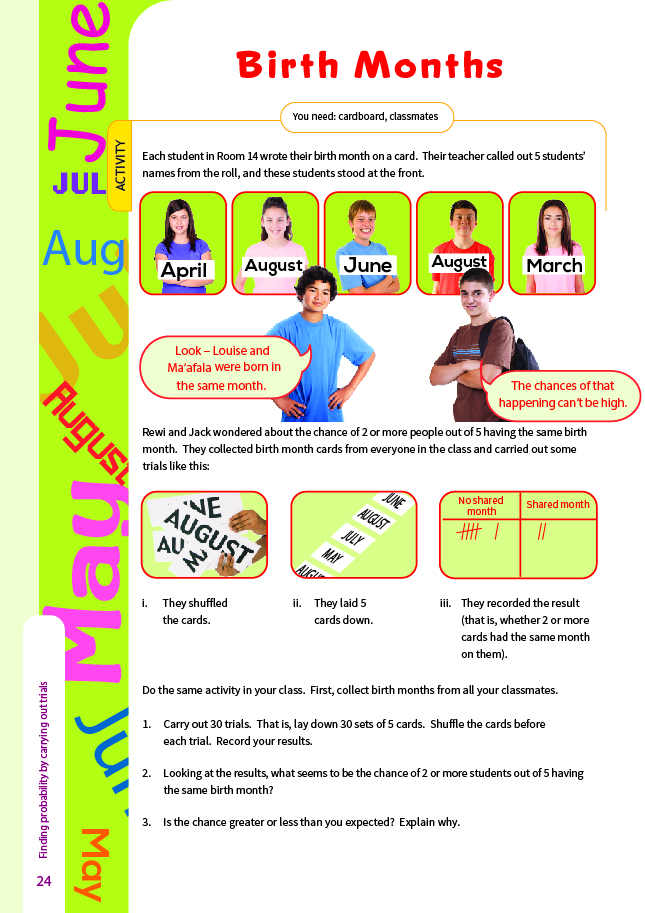This is a level 5 statistics activity from the Figure It Out series.
Click on the image to enlarge it. Click again to close. Download PDF (159 KB)
explore the outcomes of a probability activity
find theoretical probabilities
Cardboard
FIO, Level 4+, Statistics, Book Two, Birth Months, page 24
Classmates
This activity is a simplified version of the well-known “birthday paradox”. This asserts that if you put 23 people together in a room, there is a 50 percent probability that at least 2 of them will share the same birthday. If there are 30 in the room, the probability is 70 percent. And if there are 50 in the room, the probability is 97 percent. This is not what people intuitively expect. In fact, given that there are 365 days in the year, they tend to be extremely surprised when they find themselves in the company of someone who shares their birthday. This is why it is referred to as a paradox: something that seems impossible but is nevertheless true.
The students in this activity work with months (12 possibilities), which is much easier than actual birthdays (365 possibilities). They carry out what is, in effect, a simulation designed to discover experimentally the probability that 2 (or more) out of a group of 5 will share the same birth month.
When 30 results have been recorded, the students use them to calculate the long-run relative frequency of the desired outcome (that is, at least 2 cards have matching months). The calculation is done by putting the number of “successes” over the number of trials.
Long-run relative frequency is especially useful in situations where the theoretical probability of an outcome can’t be calculated (though in this case, it can). After 30 trials, the long-run relative frequency should be fairly close to what would be obtained by calculation. As always, the key to a more accurate value is a larger pool of results. The more times a simulation (experiment) is performed, the closer the relative frequency will be to the theoretical probability.
You may have students in your class who are interested in knowing how to find the theoretical probability of finding people with shared birth months in a group of 5. If so, start by explaining what is meant by complementary events. Two events are complementary if, when one does not happen, the other does. So the sum of the probabilities of two complementary events is always 1.
Sometimes it can take many calculations to find the probability of an event, and it may be a lot simpler to instead calculate the probability of the event not happening. You then take the probability of the event not happening away from 1 to find the probability of the event happening. Simple! In this activity, it is easiest to consider the probability that none of the 5 people share the same birth month.
Person 1 could have a birthday in any month in the year (12/12). Person 2’s birthday could then fall in any of the remaining 11 months (11/12). Person 3’s birthday could fall in any of the remaining 10 months (10/12), person 4’s in the remaining 9, and person 5’s in the remaining 8 (9/12 and 8/12). So the probability that there are no matches is 12/12 x 11/12 x 10/12 x 9/12 x 8/12 = 0.382. The probability that at least 2 out of the 5 do share a birth month is found by taking this probability away from 1, that is, 1 – 0.382 = 0.618, or 62 percent (to the nearest whole percent).
Answers to Activity
1. Practical activity
2. Answers will vary, but the mathematics shows that the chance of 2 or more people out of 5 having the same birth month is considerably greater than half (0.618). (1 – 12/12 x 11/12 x 10/12 x 9/12 x 8/12 )
3. Answers will vary. Most people are surprised to get a match in circumstances like this, but in reality, it is hard to avoid a match.
